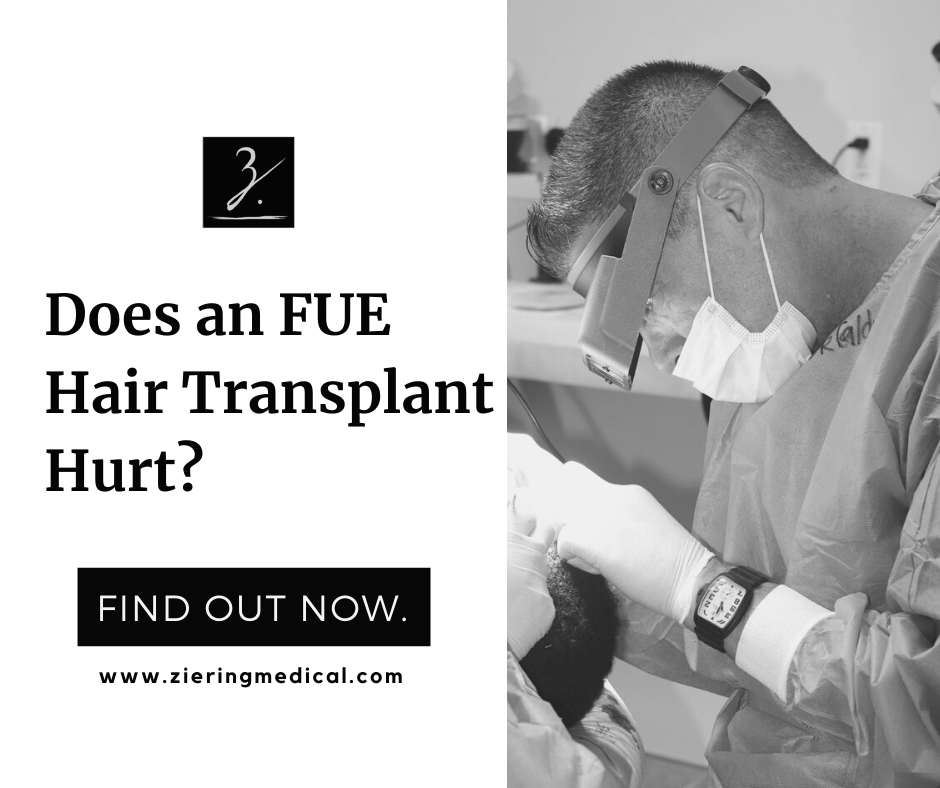Does a FUE Hair Transplant Hurt?

Table of Contents
Toggle
There are two types of surgical hair restoration techniques, both of which are utilized by Ziering Medical: Microscopically Dissected Elliptical Excision (MDEE) and Follicular Unit Excision and Extraction (FUE). MDEE, also formerly known as Follicular Unit Transplantation (FUT), entails harvesting a strip of tissue and placing it under the Ziering microscope to separate the follicular units into their naturally occurring groupings of 1 – 4 hairs. During the FUE hair transplant procedure, the donor hair follicles are harvested one at a time. While FUE has a lighter touch than MDEE, it is still understandable for patients to wonder if a FUE hair transplant will hurt. In this article, we will explain how FUE works and how Ziering Medical ensures minimum discomfort for our patients during the procedure and afterwards. Our goal is to provide patients with a better idea of what to expect and how they can prepare accordingly.
How Follicular Unit Excision and Extraction (FUE) Works
FUE is a surgical hair harvesting method used to obtain donor hair one graft at a time. It requires shaving the donor area to provide a clear view of the grafts for extraction and enhance precision during the all-important donor harvest step of the hair transplant procedure. The hair donor zone is located on the back and sides of the head and shaving this area grants surgeons increased visibility of the entire donor zone and individual hair grafts they intend to harvest.
Technological progress has resulted in more efficient graft harvesting tools. Punches are getting smaller, which reduces scarring and trauma, while motorized punches have refined the way surgeons score the upper layer of the skin while reducing the depth of the scoring. This protects the follicular unit grafts and decreases the process’ impact on the surrounding scalp tissue.
The Ziering Medical team utilizes the SAFE System designed by Dr. Jim Harris for manual FUE operations. It is a blunt, motorized dissection device that allows us to isolate follicular units from the surrounding scalp. It lets surgeons extract them directly from the scalp, all while minimizing damage to the follicles.
The Transplant Process
After harvesting the grafts, the Microscopic Follicular Unit Transplantation (MFUT) process begins. MFUT uses the same steps as Microscopically Dissected Elliptical Excision (MDEE) with the surgeon creating recipient sites and the grafts being gently, but meticulously placed into these sites at the proper angle and orientation.
FUE is an innovative harvesting technique which is great for patients looking for an alternative to the traditional MDEE method. MDEE requires harvesting an elliptical strip of tissue, dissecting them and placing the grafts into the recipient sites. Compared to that, FUE hair transplant procedure leaves microscopic, pinpoint scars throughout the donor region. These are difficult to detect as the shaved hair begins to grow back. That process takes about two weeks. In addition to this, FUE is also ideal for patients who wear their hair very short and want to have less of a visible scar as the donor area scarring is virtually undetectable at hair lengths of less than 1 cm.
Does FUE Hair Transplant Hurt?
The good news is that the procedure itself should not cause any pain. Follicular Unit Extraction can be labor intensive as each donor follicle has to be extracted with an instrument. Additionally, the results following the surgery can look tender and painful. However, during the procedure itself, a local anesthetic numbs the scalp area where the surgery will take place. At first, there may be slight discomfort, but when the anesthetic takes effect and the area is completely numb, patients should not be able to feel any pain.
It is true that pain tolerance varies from person to person. At Ziering Medical patient comfort is one of our primary concerns. Patients can let the Ziering team know how they are feeling during the hair transplantation process. So we can make the necessary adjustments.
Post-Operative Care and Comfort
After FUE hair transplant surgery, a light dressing is placed on the operative site and then removed once the patient arrives home. The scalp is left open the first night as much as possible to facilitate healing. The next day, patients should return to our clinic to have a hair wash and have their scalp inspected. Afterwards, no dressing is usually necessary. Minimal discomfort and swelling of the scalp following FUE is normal and most patients will receive prescriptions for oral pain medication to take post-operatively if needed.
Each individual patient heals at their own rate. Some may experience minor pain for a few days while others may have sore scalps for a couple of weeks. The healing process is also dependent on the number of grafts patients have had. More grafts transplanted will require longer healing times. Ziering Medical also provides growth factor injections with Z-Factors to enhance the healing process and encourage early hair regrowth.
Generally, healing takes seven to ten days. Patients who are experiencing high levels of discomfort for an extended time after their operation, or if they notice that their scalp is not healing the way it should, should contact Ziering Medical as soon as possible in order for the team to check for other underlying issues affecting the healing process.
Takeaway
Ziering Medical goes to great lengths to ensure our patients have the best possible experience with their hair restoration surgery and that they get optimal and natural-looking results. Looking forward to achieving the hair you have always dreamed of? Reach out to Ziering Medical to schedule a consultation. Ziering Medical has clinics in Beverly Hills, California; Greenwich, Connecticut; and New York City, New York.
Learn more about the recovery process after an FUE hair transplant, including how to wash your hair properly, on our blog.
